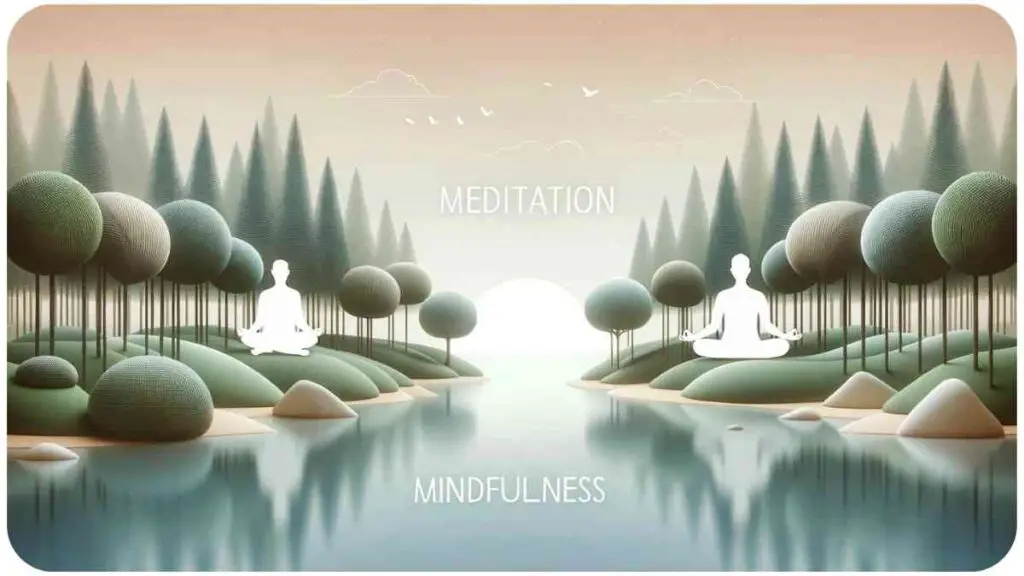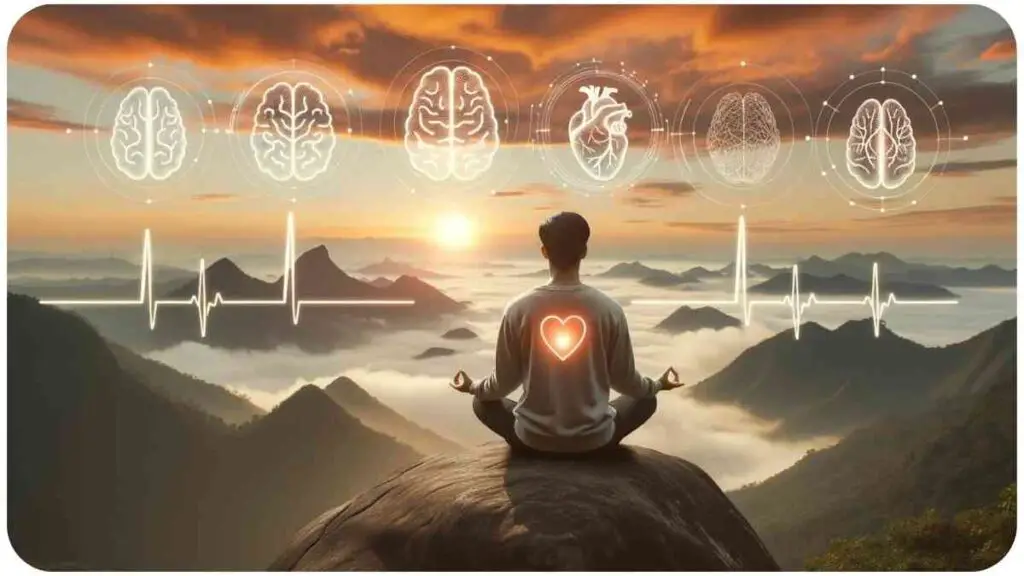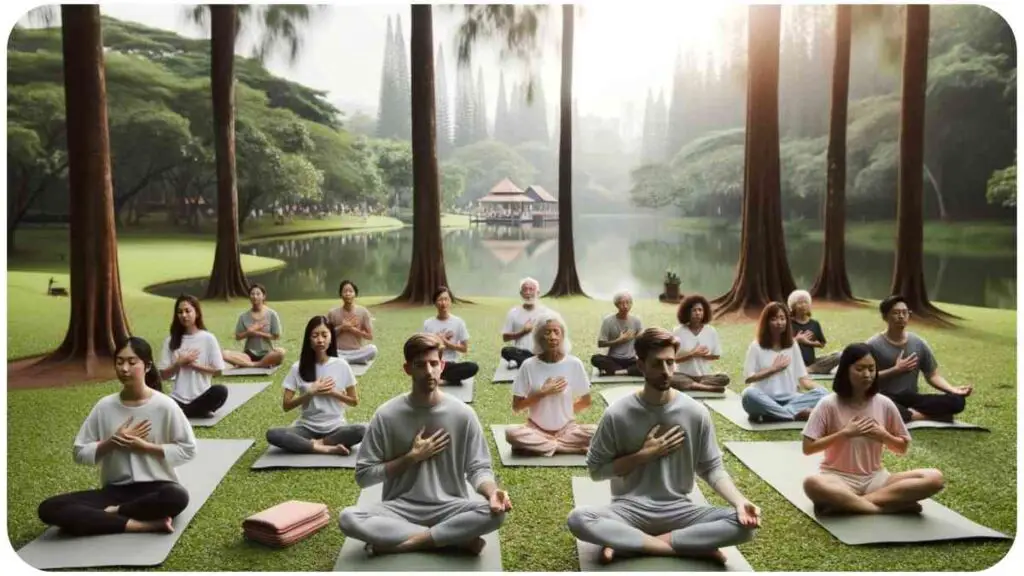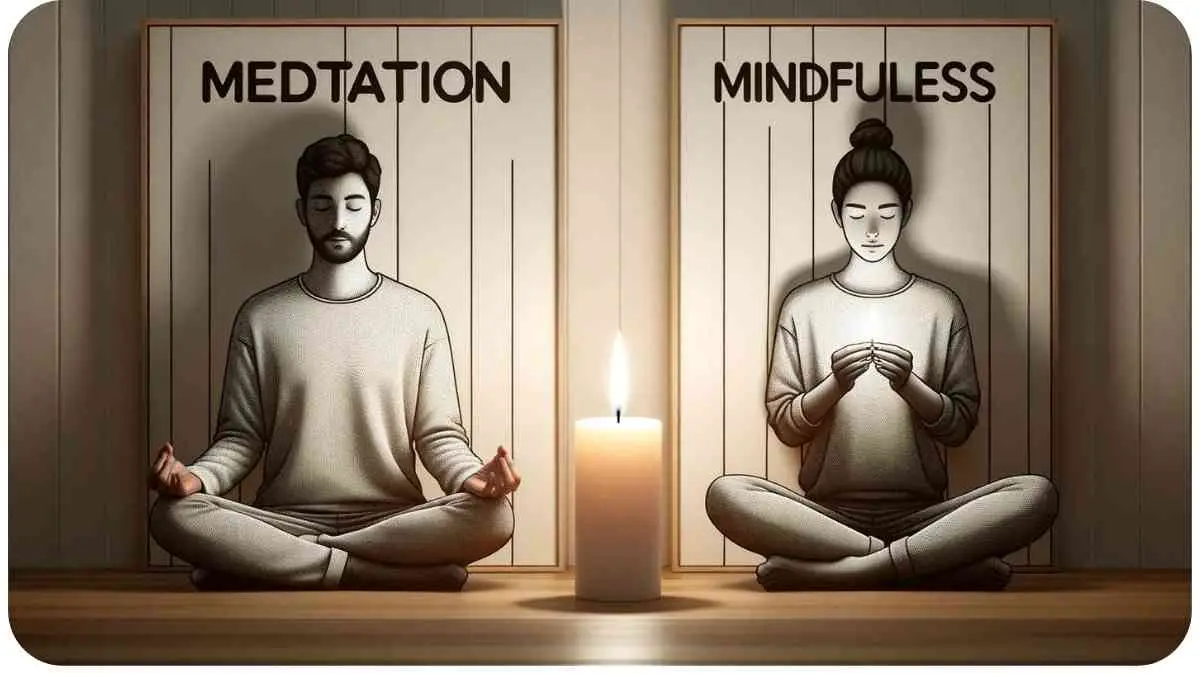Mindfulness and meditation, often used interchangeably, are two distinct practices that offer a range of benefits. While both center on the idea of awareness and present-moment attention, they differ in their methods, purposes, and origins. So, what exactly are they?
Mindfulness is about being fully present in the moment, without judgment. It’s about acknowledging and accepting our feelings, thoughts, and bodily sensations, right here and now. On the other hand, meditation is a broader practice that includes mindfulness but encompasses other techniques and goals, such as achieving a heightened level of spiritual awareness or relaxation.
| Takeaways |
|---|
| Mindfulness emphasizes being present and observing without judgment. |
| Meditation encompasses a broader range of practices. |
| Both practices have ancient roots and have evolved over time. |
| Incorporating either or both into daily routines can offer numerous benefits. |
| Challenges, while common, can be overcome with persistence and guidance. |
| Resources, from books to apps, are abundant for further exploration. |
| Both practices have scientifically proven benefits on mental well-being. |
| The choice between mindfulness and meditation depends on individual goals. |
The Importance of Differentiating the Two
Understanding the distinction between mindfulness and meditation is essential for anyone looking to improve their mental well-being. By grasping their unique characteristics, one can better decide which practice suits their needs and lifestyle.
Incorporating mindfulness practices can improve your wellness. Experience reduced stress, enhanced focus, and emotional balance. Cultivate present-moment awareness and find peace. Explore more in The Power of Mindfulness: How It Can Improve Your Wellness.
Table: Key Differences at a Glance
| Aspect | Mindfulness | Meditation |
| Definition | Being present without judgment | Broad practice including focus, awareness, etc. |
| Purpose | Increase awareness of the present | Various goals like relaxation, enlightenment |
| Duration | Momentary or prolonged | Typically structured sessions |
| Techniques | Observational, acceptance | Mantras, visualization, focus, etc. |
Historical Context
Origins of Mindfulness
Mindfulness traces its roots back to ancient Buddhist practices, where it was termed “sati.” In Buddhism, mindfulness is a part of the path to enlightenment. Over time, it has been adopted and adapted by various cultures and religions. In recent years, it has gained immense popularity in the West, partly due to the secular adaptations that make it more accessible to people regardless of their religious beliefs.
From my own studies and interactions with mindfulness experts, I’ve come to appreciate the rich tapestry of its origins and how its core principles have remained consistent over millennia.
Discover The Science of Mindfulness. Explore its effects on your brain and body. From brain structure changes to improved immunity, mindfulness offers positive health outcomes. Learn more at The Science of Mindfulness: How It Affects Your Brain and Body.
Origins of Meditation

Meditation, on the other hand, is even more ancient and universal. It’s been a part of numerous traditions, from Hindu yogic practices to Christian monastic rituals. Its primary aim varies – from seeking spiritual connection to simple relaxation. I remember my first deep dive into meditation’s history; I was astounded by the myriad of techniques and the depth of its roots in human civilization.
Table: Historical Timeline of Both Practices
| Time Period | Mindfulness | Meditation |
| Ancient Times | Practiced as “sati” in Buddhism | Found in Hindu, Buddhist, and Christian rituals |
| Middle Ages | Spread to various Asian countries | Sufi, Taoist, and other forms emerge |
| 20th Century | Introduction to the West, Jon Kabat-Zinn’s MBSR program | TM, Zen, and Yoga gain popularity in the West |
| 21st Century | Secular mindfulness booms globally | Digital platforms & apps make meditation accessible |
The intertwining histories of mindfulness and meditation show how humanity has always sought ways to understand the mind and find inner peace. The practices might have evolved, but the core essence remains the same.
Core Principles
Fundamental Concepts of Mindfulness
Mindfulness encourages living in the moment. It’s about observing without judgment – be it your thoughts, emotions, or sensations. Instead of getting lost in the past or future, mindfulness anchors you in the present. I’ve personally found that understanding and embracing this concept has been transformative. It’s like I’ve been given a tool to navigate the chaos of daily life with a calm mind.
Fundamental Concepts of Meditation
Meditation, while encompassing mindfulness, goes beyond it. It’s a structured practice with diverse techniques, from focusing on the breath to chanting mantras. The beauty of meditation is its flexibility.
Whether you’re seeking spiritual growth or just a moment of relaxation, there’s a form of meditation for you. In my journey, I’ve experimented with various techniques, each offering unique insights and benefits.
Table: Principles Side-by-Side Comparison
| Aspect | Mindfulness | Meditation |
| Focus | Present moment awareness | Can be present-focused or transcendental |
| Judgment | Non-judgmental observation | Varies, but often includes acceptance |
| Techniques | Observing thoughts, sensations, emotions | Breathing, mantras, visualization, and more |
| Goal | Enhanced awareness and acceptance | Depending on type: relaxation, spiritual growth, etc. |
Understanding the core principles of both mindfulness and meditation is pivotal. It allows one to approach each practice with clarity and intentionality, enhancing the benefits manifold.
Manage stress and find inner calm. Mindfulness can change your life. Develop resilience and well-being. Explore stress management techniques in The Secret to Stress Management: How Mindfulness Can Change Your Life.
Practical Applications
Mindfulness in Everyday Life
Mindfulness isn’t restricted to a specific time or place. It can be integrated into our daily routines. Whether you’re brushing your teeth, eating a meal, or walking to work, you can practice mindfulness. The idea is to be completely present during these activities.
For instance, while having breakfast, instead of scrolling through your phone, focus on the taste, texture, and aroma of the food. This not only enhances the experience but also helps in reducing stress. I remember when I first started incorporating mindfulness into my daily chores; it felt like I was truly living each moment, rather than just going through the motions.
Meditation in Structured Practice
Meditation, on the other hand, often requires a more structured approach. While it can be practiced anywhere, many prefer a quiet, dedicated space. It’s about setting aside specific time, even if it’s just a few minutes, to meditate.
Techniques can vary – from guided meditations to silent contemplative sessions. My personal favorite is the early morning meditation sessions. The tranquility of dawn, coupled with the meditative focus, sets a positive tone for the rest of the day.
The power of mindfulness in combating trauma and PTSD is transformative. Reduce symptoms, promote emotional healing, and enhance well-being. Discover more at The Power of Mindfulness in Combating Trauma and PTSD.
Table: Applications in Various Scenarios
| Scenario | Mindfulness Approach | Meditation Approach |
| Morning Routine | Being present while brushing, bathing | Starting the day with a 10-minute meditation session |
| Work/Studies | Taking mindful breaks, deep breathing | Designated meditation breaks, group sessions at workplace |
| Meal Times | Savoring each bite, gratitude for food | Pre-meal short meditation for gratitude |
| Evening Relaxation | Mindful reading, listening to music | Deep relaxation or body scan meditation before sleep |
The beauty of both mindfulness and meditation lies in their adaptability. They can be molded to fit into any schedule or lifestyle, making them accessible to all.
Benefits and Effects
Physical and Mental Benefits of Mindfulness

Mindfulness, over the years, has been associated with a plethora of health benefits. Physically, it helps in reducing blood pressure, improving sleep, and enhancing overall well-being. Mentally, it’s a boon for reducing anxiety, stress, and depressive symptoms.
From my personal experience, integrating mindfulness into daily life has brought about a sense of calm and has drastically improved my reaction to stressful situations.
Physical and Mental Benefits of Meditation
Meditation, with its varied techniques, offers a wide range of benefits. From improving concentration and focus to fostering a deeper sense of peace and spiritual growth, the advantages are manifold.
Additionally, regular meditation practice is known to bring about physical benefits such as reduced inflammation, better sleep, and even changes in brain structure that are associated with enhanced emotional health. My own journey with meditation has seen improvements in my attention span and a more profound sense of connection with my inner self.
Table: Documented Health Benefits Comparison
| Benefit Type | Mindfulness | Meditation |
| Physical | Improved sleep, Lower blood pressure | Reduced inflammation, Enhanced immune response |
| Mental | Reduced stress, Enhanced emotional regulation | Improved focus, Deeper sense of peace |
| Emotional | Better resilience, Enhanced self-awareness | Increased compassion, Reduced symptoms of anxiety and depression |
Methods and Techniques
Popular Mindfulness Exercises
Mindfulness exercises are versatile and can be practiced virtually anywhere. Some popular methods include:
- Breath Awareness: Focus solely on your breathing. Observe the inhalation and exhalation without trying to modify it.
- Five Senses Exercise: Take a moment to notice what you’re sensing in a particular situation. What do you see, hear, smell, taste, and feel?
- Body Scan: Mentally scan your body from head to toe, observing any tension, warmth, or other sensations.
From my professional journey, I’ve realized the significance of starting small. Initially, even a 2-minute breath awareness exercise during a hectic day can make a profound difference.
Combat stress with mindfulness. Learn effective techniques in Mindfulness vs Stress: How to Win the Battle with These Proven Techniques. Incorporate mindfulness into daily life and manage stress effectively.
Popular Meditation Techniques
Meditation encompasses various techniques, some of which are:
- Concentration Meditation: Focus on a single point. This could involve following the breath, chanting a mantra, or staring at a candle flame.
- Guided Meditation: Led by a trained practitioner or teacher, it involves visualizing a specific image or setting to bring about inner peace.
- Loving-kindness or Metta Meditation: It’s about developing loving and kind feelings towards oneself and others.
My experimentation with different techniques has been an enlightening experience. Guided meditations, in particular, were a game-changer for me during the initial days, offering a structured approach to inner peace.
Table: Techniques and Their Purposes
| Technique | Mindfulness/Meditation | Purpose |
| Breath Awareness | Mindfulness | Grounding, Calming |
| Five Senses Exercise | Mindfulness | Enhancing present-moment awareness |
| Body Scan | Mindfulness | Observing bodily sensations, Relaxation |
| Concentration Meditation | Meditation | Improving focus and attention |
| Guided Meditation | Meditation | Structured path to relaxation, Imagery-based peace |
| Loving-kindness Meditation | Meditation | Developing compassion, Reducing negative emotions |
Exploring various mindfulness and meditation techniques allows one to find the methods that resonate the most, ensuring a sustainable and enjoyable practice.
Challenges and Misconceptions
Common Challenges in Practicing Mindfulness

Mindfulness, while simple in concept, can be challenging to practice consistently. Distractions, impatience, and expecting quick results are common hurdles. In my initial days, the constant barrage of thoughts during mindfulness sessions was overwhelming. However, with persistence, I learned that the key is not to silence the mind but to observe without judgment.
Common Challenges in Practicing Meditation
Meditation comes with its set of challenges, such as finding a quiet space, dedicating time, or even just sitting still. The misconceptions around needing to have an ’empty mind’ can also deter many. My personal tip? Start with short sessions and gradually increase the duration. And remember, it’s okay for the mind to wander; gently bring it back.
Table: Misconceptions Debunked
| Misconception | Reality |
| Mindfulness means having an empty mind | It’s about observing thoughts without judgment, not eliminating them |
| Meditation requires hours of dedication daily | Even a few minutes daily can offer benefits |
| Only certain people (like monks) can meditate | Everyone, irrespective of age, profession, or background, can meditate |
Image: A puzzled individual trying to meditate, symbolizing the misconceptions many have about the practice.
Image: A serene meditator with a light aura, representing the peace and clarity achieved through consistent practice.
Addressing challenges and debunking misconceptions is crucial for a fulfilling journey with mindfulness and meditation. With patience and persistence, the rewards are profound.
Incorporating Both in Daily Life
When to Use Mindfulness
Mindfulness is versatile and can seamlessly blend into our daily routines. Moments like waiting in line, taking a shower, or even during a mundane task at work are opportunities to practice mindfulness.
The idea is to fully immerse yourself in the current moment, irrespective of the activity. I often use my commute time as a ‘mindfulness moment,’ where I observe the surroundings, listen to the hum of the city, and feel the movement of the vehicle. It’s a refreshing way to start and end the workday.
When to Use Meditation
Meditation, while more structured, can still be incorporated into daily life. Setting aside a specific time, like early morning or before bed, is ideal for most. However, even during a short break at work or in the middle of a hectic day, a few minutes of focused meditation can rejuvenate the mind. Personally, I’ve set up a small meditation corner at home. It’s my go-to place whenever I need a mental reset.
Table: Choosing the Right Practice for the Situation
| Situation | Mindfulness Approach | Meditation Approach |
| Morning Routine | Being present during activities like brushing | A short meditation session to set the tone for the day |
| Work/Studies | Mindful breaks to stretch or breathe | Guided meditation during lunch breaks |
| Challenging Situations | Observing emotions without reacting | Deep breathing or grounding meditation |
| Before Sleep | Mindful reflection of the day | Relaxation meditation for a peaceful sleep |
The beauty of both practices lies in their adaptability. Whether you have a minute or an hour, there’s always an opportunity to cultivate mindfulness or meditate.
Personal Experiences
My Journey with Mindfulness
When I started my mindfulness journey, it was more out of curiosity than conviction. The initial days were filled with impatience and skepticism. But as days turned into weeks, I began to notice subtle changes. Moments of stress became more manageable, and I found joy in the little things. The practice taught me the value of the present, a lesson I cherish and try to imbue in every aspect of my life.
My Journey with Meditation
Meditation, for me, was a refuge during challenging times. The structured practice offered solace and clarity. Over the years, I’ve experimented with various techniques, from guided to transcendental, each offering unique insights. It’s been a transformative journey, one that has not only brought inner peace but also a deeper understanding of myself.
Table: Lessons Learned from Personal Practice
| Practice | Challenges Faced | Insights Gained |
| Mindfulness | Distractions, Impatience | Value of the present, Joy in simplicity |
| Meditation | Finding time, Skepticism | Inner peace, Self-awareness, Clarity in chaos |
Resources and Further Reading
Recommended Books on Mindfulness
For those eager to delve deeper into mindfulness, literature can be a goldmine of knowledge. Over the years, several books have shaped my understanding and practice:
- “Wherever You Go, There You Are” by Jon Kabat-Zinn: A modern classic that breaks down mindfulness in an accessible manner.
- “The Miracle of Mindfulness” by Thich Nhat Hanh: A beautiful insight into the world of mindfulness from the perspective of a Zen master.
- “Radical Acceptance” by Tara Brach: A transformative book that blends mindfulness with self-compassion.
Recommended Books on Meditation
Meditation, with its ancient roots and diverse techniques, has been the subject of countless books. Some that have profoundly impacted my journey include:
- “The Art of Happiness” by Dalai Lama: A blend of Buddhist teachings and meditation practices aimed at cultivating joy.
- “Meditation for Beginners” by Jack Kornfield: A straightforward guide for those new to meditation.
- “10% Happier” by Dan Harris: A skeptic’s journey into the world of meditation, offering a refreshing and relatable perspective.
Table: Top Resources for Beginners
| Category | Mindfulness | Meditation |
| Books | “The Miracle of Mindfulness” | “The Art of Happiness” |
| Apps | Headspace, Calm | Insight Timer, 10% Happier |
| Online Courses | “Mindfulness-Based Stress Reduction (MBSR)” | “Transcendental Meditation Introduction Course” |
| Workshops | Local mindfulness retreats | Meditation centers and group sessions |
FAQs on Mindfulness and Meditation
Common Questions Answered
Over the years, I’ve been approached with numerous questions on both practices. Here are some common ones answered:
- Is mindfulness a form of meditation?
While mindfulness is a form of meditation, not all meditation is mindfulness. Mindfulness is about being present, while meditation encompasses a range of techniques and goals. - How long should I meditate for?
There’s no one-size-fits-all answer. For beginners, starting with 5-10 minutes daily is beneficial. As you become more comfortable, you can gradually increase the duration. - Can children practice mindfulness and meditation?
Absolutely! In fact, introducing these practices early on can equip children with tools to handle stress and emotions better.
Further Reading
For those interested in diving deeper into the nuances of mindfulness and meditation, here are some recommended articles:
BetterUp: Mindfulness vs. Meditation
An insightful article that delves into the distinctions between mindfulness and meditation, and how they intertwine in our daily lives.
Positive Psychology: Differences Between Mindfulness & Meditation
A comprehensive piece from Positive Psychology that breaks down the core principles of both practices and their unique benefits.
Forbes Health: Mindfulness vs. Meditation
Forbes provides a nuanced take on the topic, shedding light on the science behind these practices and their implications for mental well-being.
FAQs
What is the main difference between mindfulness and meditation?
Mindfulness is a form of meditation that emphasizes being fully present and observing without judgment. Meditation, on the other hand, encompasses a broader range of practices, some of which may not focus solely on present-moment awareness.
Can mindfulness and meditation be practiced simultaneously?
Yes, in fact, many meditation techniques incorporate elements of mindfulness. For instance, a guided meditation session might also encourage participants to be mindful of their breath or bodily sensations.
How long does it take to see benefits from practicing mindfulness or meditation?
The benefits can be experienced almost immediately, especially in terms of feeling more relaxed or centered. However, long-term benefits like improved mental well-being or reduced stress may require consistent practice over weeks or months.
Is there any scientific evidence supporting the benefits of mindfulness and meditation?
Absolutely! Numerous studies have shown the positive effects of both practices on mental health, cognitive function, and even physical health. These benefits range from reduced symptoms of anxiety and depression to improved focus and memory.
Are there any risks associated with mindfulness or meditation?
For most people, these practices are safe and beneficial. However, for individuals with certain mental health conditions, intense meditation or mindfulness sessions might bring up challenging emotions. It’s always advisable to consult with a healthcare professional if unsure.

Hello, my name is Hellen James! I am a yoga teacher and writer who loves to share information about how you can achieve a more fulfilling life. I have been practicing mindfulness, yoga, and meditation for over 10 years. My passion for these practices has led me to teach them to others.

